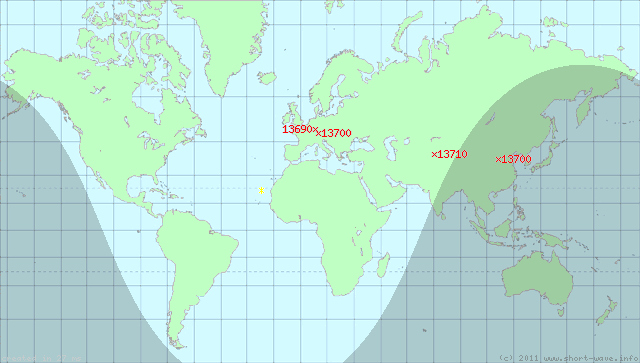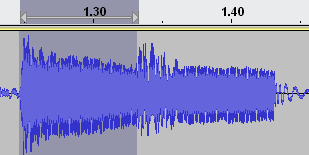Tuesday 12 July, 2011, 14:39 - Broadcasting
Tuning around the 13 MHz broadcast band, Radio Nederland on 13700 kHz being transmitted from Wertachtal in Germany was sounding rather odd. It had a very pronounced echo which made understanding it very difficult (if you could understand Dutch in the first place!)You will note in the brief recording that towards the end the echo becomes less evident and listening over a longer period it was clear that the echo faded in and out. This can only mean one of two possible things:
(1) The echo was being caused by transmitting the same material, slightly delayed, from a second transmitter site; or
(2) The echo was being caused by receiving duplicated copies of the same material, delayed by some other means.

As far as was apparent, there were no other transmitters being used on that frequency by Radio Nederland, though there was meant to be a transmitter in China on the same frequency which might have been erroneously relaying the programme by mistake. But the cause is more likely to be some other means. Could it, for example, have been caused by being propagated all the way around the Earth.
 A quick calculation shows that the delay associated with a round the globe trip is approximately 133 ms (40000 km at 300000 km/s). A snapshot of the pips on the hour is shown on the right, indicating a delay of about 80 ms - so it can't be that! Even if one signal were short-path and the other long-path the delay would only be slightly shorter at around 127 ms so it's not that either.
A quick calculation shows that the delay associated with a round the globe trip is approximately 133 ms (40000 km at 300000 km/s). A snapshot of the pips on the hour is shown on the right, indicating a delay of about 80 ms - so it can't be that! Even if one signal were short-path and the other long-path the delay would only be slightly shorter at around 127 ms so it's not that either.No other signals in the band were exhibiting the same characteristics which is usually a good sign that it's not a propagation issue (though the BBC Russian transmission on 13745 kHz from the UK did have some very odd rapid fading on it).
The most likely cause seems to be that there were two transmitters on-air at the same time on the same frequency with the same material. Of the other Radio Nederland transmissions due to be on at the same time, all were present and correct which would suggest that it wasn't a transmitter erroneously on the wrong frequency.
Very odd...!
Paul Burnett
Thursday 26 July, 2012, 13:16
There is a third theory, which is the possibility of receiving the same signal from the same (one)tansmitter via ground waves AND skywaves at the same time. the ground wave signal will arrive at the antenna faster than the skywave signal which will arrive behind the groundwave signal which has to travel up to the ionosphere and back down to earth, via a longer route.73 de G1DAT
Thursday 9 August, 2012, 15:38
Hi Paul,Nice theory. Unfortunately the typical distance to the ionosphere is about 150km, meaning a round-trip would be 300km. At the speed of light this would only represent a trip time of 1 milliSecond, and not the tens of milliSeconds of delays encountered.
73 de G1JAJ
